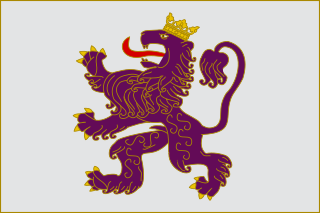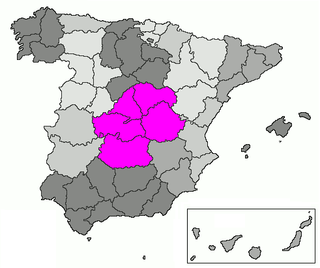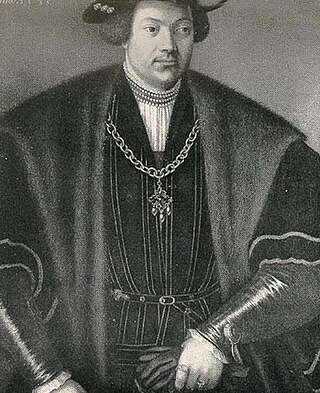
New Spain, officially the Viceroyalty of New Spain, originally the Kingdom of New Spain, was an integral territorial entity of the Spanish Empire, established by Habsburg Spain during the Spanish conquest of the Americas and having its capital in Mexico City. Its jurisdiction comprised a large area of the southern and western portions of North America, mainly what is now Mexico and the Southwestern United States, but also California, Florida and Louisiana; Central America, the Caribbean, and northern parts of South America; several Pacific archipelagos, most notably the Philippines and Guam. Additional Asian colonies included "Spanish Formosa", on the island now known as Taiwan.

The Viceroyalty of Peru, officially known as the Kingdom of Peru, was a Spanish imperial provincial administrative district, created in 1542, that originally contained modern-day Peru and most of the Spanish Empire in South America, governed from the capital of Lima. Peru was one of the two Spanish viceroyalties in the Americas from the sixteenth to the eighteenth centuries.

The Spanish Empire, sometimes referred to as the Hispanic Monarchy or the Catholic Monarchy, was a colonial empire governed by Spain between 1492 and 1976. In conjunction with the Portuguese Empire, it was the first empire to usher the European Age of Discovery and achieve a global scale, controlling vast portions of the Americas, Africa, various islands in Asia and Oceania, as well as territory in other parts of Europe. It was one of the most powerful empires of the early modern period, becoming known as "the empire on which the sun never sets". At its greatest extent in the late 1700s and early 1800s, the Spanish Empire covered over 13 million square kilometres, making it one of the largest empires in history.

The Kingdom of León was an independent kingdom situated in the northwest region of the Iberian Peninsula. It was founded in 910 when the Christian princes of Asturias along the northern coast of the peninsula shifted their capital from Oviedo to the city of León. The kings of León fought civil wars, wars against neighbouring kingdoms, and campaigns to repel invasions by both the Moors and the Vikings, all in order to protect their kingdom's changing fortunes.

New Castile is a historic region of Spain. It roughly corresponds to the medieval Moorish Taifa of Toledo, taken during the Reconquista of the peninsula by Christians and thus becoming the southern part of Castile. The extension of New Castile was formally defined after the 1833 territorial division of Spain as the sum of the following provinces: Ciudad Real, Cuenca, Guadalajara, Madrid and Toledo.

The University of Salamanca is a Spanish public research university, located in Salamanca, in the autonomous community of Castile and León. It was founded in 1218 by King Alfonso IX. It is the oldest university in the Hispanic world and one of the oldest in the world in continuous operation. It has over 30,000 students from 50 different nationalities.

Habsburg Spain refers to Spain and the Spanish Empire, also known as the Catholic Monarchy, in the period from 1516 to 1700 when it was ruled by kings from the House of Habsburg. It had territories around the world, including modern-day Spain, a piece of south-eastern France, eventually Portugal and many other lands outside the Iberian Peninsula, like in the Americas. Habsburg Spain was a composite monarchy and a personal union. The Habsburg Spanish monarchs of this period are chiefly Charles I, Philip II, Philip III, Philip IV and Charles II. In this period the Spanish empire was at the zenith of its influence and power. Spain, or "the Spains", referring to Spanish territories across different continents in this period, initially covered the entire Iberian peninsula, including the crowns of Castile, Aragon and from 1580 Portugal. It then expanded to include territories over the five continents, consisting of much of Latin America and the West Indies in the Americas, the Low Countries, Belgium, Luxembourg, Italian territories and France in Europe, Portuguese possessions such as small enclaves like Ceuta and Oran in North Africa, and the Philippines and other possessions in Southeast Asia. The period of Spanish history has also been referred to as the "Age of Expansion".

The Asiento de Negros was a monopoly contract between the Spanish Crown and various merchants for the right to provide African slaves to colonies in the Spanish Americas. The Spanish Empire rarely engaged in the trans-Atlantic slave trade directly from Africa itself, choosing instead to contract out the importation to foreign merchants from nations more prominent in that part of the world; typically Portuguese and Genoese, but later the Dutch, French, and British. The Asiento did not concern French or British Caribbean but Spanish America.

The Iberian Union was the dynastic union of Spain and Portugal, and of their respective colonial empires, that existed between 1580 and 1640 and brought the entire Iberian Peninsula except Andorra, as well as Portuguese and Spanish overseas possessions, under the Spanish Habsburg monarchs Philip II, Philip III, and Philip IV. The union began after the Portuguese crisis of succession and the ensuing War of the Portuguese Succession, and lasted until the Portuguese Restoration War, during which the House of Braganza was established as Portugal's new ruling dynasty with the acclamation of John IV as the new King of Portugal.

This article covers the development of Spain's economy over the course of its history.

The Crown of Castile was a medieval polity in the Iberian Peninsula that formed in 1230 as a result of the third and definitive union of the crowns and, some decades later, the parliaments of the kingdoms of Castile and León upon the accession of the then Castilian king, Ferdinand III, to the vacant Leonese throne. It continued to exist as a separate entity after the personal union in 1469 of the crowns of Castile and Aragon with the marriage of the Catholic Monarchs up to the promulgation of the Nueva Planta decrees by Philip V in 1715.

Lope de Barrientos (1382–1469), sometimes called Obispo Barrientos, was a powerful clergyman and statesman of the Crown of Castile during the 15th century, although his prominence and the influence he wielded during his lifetime is not a subject of common study in Spanish history.

Gabriel von Salamanca was a Spanish nobleman who served as general treasurer and archchancellor of the Habsburg archduke Ferdinand I of Austria from 1521 to 1526. He was elevated to a Count of Ortenburg in 1524.

The history of Lima, the capital of Peru, began with its foundation by Francisco Pizarro on January 18, 1535. The city was established on the valley of the Rímac River in an area populated by the Ichma polity. It became the capital of the Viceroyalty of Peru and site of a Real Audiencia in 1543. In the 17th century, the city prospered as the center of an extensive trade network despite damage from earthquakes and the threat of pirates. However, prosperity came to an end in the 18th century due to an economic downturn and the Bourbon Reforms.

Medrano may refer to:

The Region of León, Leonese region or Leonese Country is a historic territory defined by the 1833 Spanish administrative organisation. The Leonese region encompassed the provinces of Salamanca, Zamora, and León, now part of the modern Spanish autonomous community of Castile and León. As is the case with other historical regions, and continuing with centuries of history, the inhabitants of the Leonese region are still called Leonese. Even today, according with official autonomous government, the historical territorial adjective is used in addition with the modern annexed territory, the rest of Old Castile, being "Castilians and Leonese".

Habsburg Spain was at the height of its power and cultural influence at the beginning of the 17th century, but military, political, and economic difficulties were already being discussed within Spain. In the coming decades these difficulties grew and saw France gradually taking Spain's place as Europe's leading power through the later half of the century. Many different factors, including the decentralized political nature of Spain, inefficient taxation, a succession of weak kings, power struggles in the Spanish court and a tendency to focus on the American colonies instead of Spain's domestic economy, all contributed to the decline of the Habsburg rule of Spain.

The Treaty of Madrid, also known as the Earl of Sandwich's Treaty, was signed on 23 May, 1667 by England and Spain. It was one of a series of agreements made in response to French expansion under King Louis XIV.

García de Medrano y Álvarez de los Ríos was the regent of Navarre and Seville, professor at the University of Salamanca, Knight of the Order of Santiago, a crime prosecutor in Valladolid, Judge of Valladolid, Minister of the Treasury, Minister of the Indies, prosecutor of the Council of Castile, Minister of Castile and of its Chamber, Minister of Inquisition and again counselor of Castile until his death. He was a member of the powerful and academic Medrano family, and a relative of Luisa de Medrano, the first female professor at the University of Salamanca. His son Don García de Medrano y Mendizabal was the first Count of Torrubia, a Spanish noble title created on August 29, 1694, by King Carlos II.

The Spanish Decadence was the gradual process of exhaustion and attrition suffered by the Spanish Monarchy throughout the 17th century, during the reigns of the so-called minor Habsburgs ; a historical process simultaneous to the so-called general crisis of the 17th century, but which was especially serious for Spain, to such an extent that it went from being the hegemonic power in Europe and the largest economy in the world in the 17th century to becoming an impoverished and semi-peripheral country.

















